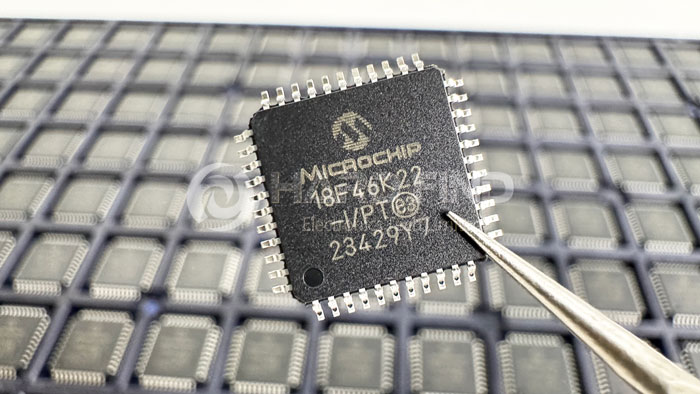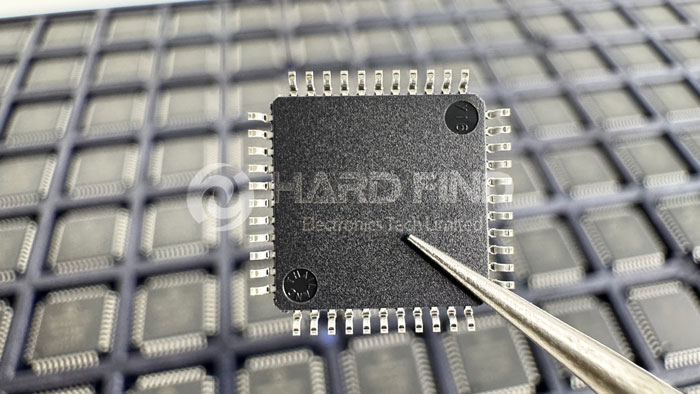In embedded system design, the choice of microcontroller (MCU) directly affects the performance, cost, and development cycle of the product. As a classic 8-bit enhanced MCU, Microchip Technology's PIC18F46K22-I/PT has become an ideal choice for many low and medium-complexity embedded projects with its balanced resource allocation, rich peripheral modules, and industrial-grade reliability.

PIC18F46K22-I/PT Overview
Core Architecture and Performance Advantages
PIC18F46K22-I/PT is 8-bit microcontroller of Microchip PIC® XLP™ Series. It is based on an improved PIC18 core, with a maximum main frequency of 64 MHz and an instruction execution speed of 16 MIPS. Its storage resources include 64 KB Flash (program storage), 3.8 KB RAM (data cache), and 1 KB EEPROM (non-volatile storage), which can meet the code and data storage requirements of most control tasks. It adopts a 44-pin TQFP package and supports an industrial temperature range of -40°C to +85°C, suitable for harsh environments.
CPU Architecture
• 8-bit enhanced PIC18 core, supports single-cycle instruction execution (except branch/jump instructions).
• Maximum operating frequency is 64 MHz (achieved by internal 16 MHz oscillator through 4×PLL multiplication).
• Instruction throughput is 16 MIPS (million instructions per second).
• Supports hardware multiplier (8×8 bit) and hardware divider (16/8 bit) to accelerate numerical operations.
Clock System
• Clock source selectable:
Internal oscillator: 31 kHz (low power mode) to 16 MHz (high-frequency mode), accuracy ±1%.
External oscillator: supports LP, XT, HS, and HSPLL modes, up to 64 MHz.
• Integrated Fail-Safe Clock Monitor (FSCM), automatically switches to the internal backup clock when the main clock fails.
Key Peripheral Modules
• High-precision ADC: Integrated 13-channel 12-bit analog-to-digital converter, sampling rate up to 100 kSPS, supports differential input and automatic scanning functions, suitable for sensor signal acquisition.
• Enhanced PWM (ECCP): Provides 4 PWM outputs, supports dead zone control, phase adjustment, and multi-mode modulation, and can directly drive motors or switch power supplies.
• Communication interface: Equipped with 2 UARTs, 2 SPIs, and 1 I²C modules, supporting multi-device cascading and protocol expansion.
• Timing and real-time control: Contains 4 16-bit timers, hardware RTCC (real-time clock calendar), and window watchdog (WWDT) to ensure system timing accuracy.
• mTouch technology: Built-in capacitive touch sensing interface, interactive design such as buttons and sliders can be realized without external components.
Memory Configuration
As Harvard architecture devices, the data and program memories use separate buses, which allows concurrent access to the two memory spaces. For practical purposes, the data EEPROM can be regarded as a peripheral device since it is addressed and accessed through a set of control registers.
With 64 KB FLASH,it allows 100 thousand erase/write cycles (typical), with data retention >40 years. It supports Runtime Self-Programming (RTSP), allowing firmware to be updated online. Besides, with 1,024 bytes of independent nonvolatile storage, supporting 1 million erase and write cycles (typical).
PIC18F46K22-I/PT Applications
In the field of industrial control, PIC18F46K22-I/PT is often used in PLC submodules or distributed I/O nodes. For example, an automated production line uses it to control stepper motors, generates precise PWM waveforms through the ECCP module to drive the motors, and uses the ADC to collect photoelectric encoder feedback signals in real time to form a closed-loop control. In addition, its SPI interface can be connected to the RS-485 transceiver to implement Modbus protocol communication and interact with the host computer.

PIC18F46K22-I/PT
For the needs of home appliance control, the mTouch capacitive sensing function of this chip is widely used in smart panel design. Taking smart air conditioners as an example, developers can directly implement touch buttons and sliders through copper foil on the PCB, eliminating the cost of mechanical switches. Combined with the I²C interface to connect to the OLED display, the temperature, humidity, and operating mode can be displayed in real time. The low power consumption characteristics (sleep current as low as 100 nA) also make it suitable for battery-powered remote controls or wireless sensors.
In the body control system, PIC18F46K22-I/PT can be used for the window lift control module. The motor current is monitored by ADC, and the overcurrent protection algorithm is combined to prevent stall damage; at the same time, the CAN bus expansion chip (such as MCP2551) is used to communicate with the vehicle's main control unit. In tire pressure monitoring (TPMS) applications, its 12-bit ADC can accurately process pressure sensor signals and upload data through the Sub-1GHz RF module.

PIC18F46K22-I/PT
Portable medical devices (such as blood glucose meters) usually require low power consumption and high precision. Its ADC automatic scanning mode can continuously collect multiple bioelectric signals, and cooperate with software filtering algorithms to improve the signal-to-noise ratio. EEPROM memory is used to save user calibration parameters to ensure measurement consistency. In the design of a handheld oximeter, the developer used its PWM module to dynamically adjust the LED light source intensity and optimize the photoelectric detection accuracy.
Conclusion
Compared with 32-bit MCU, 8-bit architecture makes it difficult to handle image processing, complex algorithms (such as machine learning), and other tasks. Therefore, PIC18F46K22-I/PT is more suitable for simple control tasks. For small and medium-sized projects that pursue fast implementation and controllable costs, you can consider using this chip.